Instruction
Four keys to make you a smarter golfer
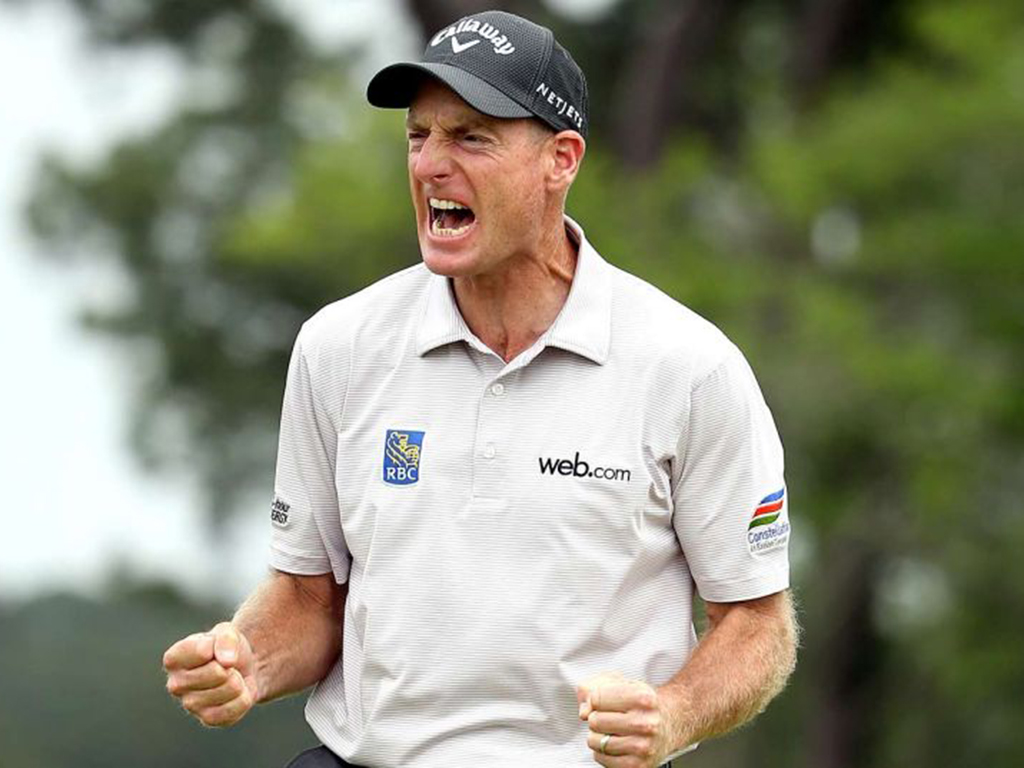
Are you a smart golfer? Or do you regularly toss away unnecessary strokes due to mental mistakes?
Working with golfers at all levels on the mental/emotional game and having spent the better part of my entire life around the game, the things I’ve seen very smart people do on the golf course really leaves me scratching my head sometimes.
You don’t necessarily need to practice for hours and hours to lower your scores; all it takes is smarter thinking and preparing with a purpose.
What Most Golfers Do
Let’s start with an example:
A few months ago I was standing on the first tee at an event greeting players. Some arrived from the parking lot after racing across town to make their tee time, while others arrived after a brief stint on the practice tee.
The first hole was a slightly elevated par-4 about 410 yards, straight away with water down the right side. The hole opened up on the left — a wide fairway, a generous cut of rough and then trees about 30 yards beyond. On that day there was a slight cross-wind blowing from left to right.
As the players pulled up to the tee, about 95 percent of them pulled the driver from their bag without considering the shape of the hole, hazards or wind. Almost all walked up on the tee, aimed down the middle, and watched as the ball sailed into the water on the right. Every second player watched their ball start in the fairway or right-center, spin right and splash!
It was bewildering to see the look of surprise on their faces afterwards. What were they expecting? About 80 percent of golfers slice the ball for various reasons, yet none of these players considered aiming away from trouble and avoiding the hazard, even with wind blowing towards the water on the right.
Yes, mistakes were made during the swings, but these penalty strokes could have been saved even before stepping on the tee.
Are You a Smart Player?
My job is to essentially help performers/athletes get out of their own way. There are so many things that keep athletes from maximizing their performance, but the most common is just plain lack of thought.
Questions to ask yourself:
Do you properly prepare to play? Are you aware of your strengths and limitations? Do you play the course like a chess match, strategically placing your ball around the course?
Or, do you fall into the same traps that the players in the example above fall into — little to no warm-up, not paying attention to what the course gives you and not playing to your strengths? Do you makes mistakes that could have easily been avoided? Do you play some good holes but also have “too many” disaster holes?
A Few Ideas to Help You Play Smart
Here are a few simple ways — some factors you can directly control — to smarten up and immediately lower your scores.
1. Prepare yourself to play! Most players just do not allow for adequate warm-up time — a key part to allowing yourself to play to your strengths. Pay attention to your warm-up and get a sense for the flight of the ball — it will enable you to know “what you’ve got” that day. Also, standing on the first tee with the right club in your hand and thinking strategically can help build positive momentum for the remainder of your round.
2. Have a plan on how to play each hole. Evaluate each hole by first having a general focus of the entire hole including all trouble spots. Error away from trouble, then narrow your focus of the hole on a specific target area and hit the shot there. Remember that each hole is a chess game vs. the architect’s design, and you must know how to position your strength against the hole’s limitations.
3. Start slow and build. Stick your toe in to test the water early in the round and focus on keeping the ball in play. Hit the club that makes you feel most comfortable, allowing the nerves to settle and dissolve over the first few holes. Many players ignite the nerves by playing well beyond their capabilities very early in rounds. This approach puts players on the emotional roller coaster early in the round and it can be difficult to overcome.
4. Develop a “stock shot.” Every player will feel uncomfortable on certain holes in a round. What may be a comfortable-looking hole for me might be very uncomfortable for you. You should develop a shot you can trust to keep in play. It doesn’t matter what the shot looks like as long as it produces the result. Smart players acknowledge when things aren’t quite right and have a “go-to” shot when things get uncomfortable. This helps to eliminate big numbers on holes that just don’t fit your eye.
While there are many things you can’t control in the game of golf, being prepared and being smart are factors you can control. Many players like Jim Furyk have had great careers and made tremendous livings in the game of golf maximizing their abilities by having a plan and playing smart.
Use your head and see your scores drop!
- LIKE279
- LEGIT74
- WOW34
- LOL6
- IDHT2
- FLOP4
- OB3
- SHANK14
Instruction
The Wedge Guy: The easiest-to-learn golf basic

My golf learning began with this simple fact – if you don’t have a fundamentally sound hold on the golf club, it is practically impossible for your body to execute a fundamentally sound golf swing. I’m still a big believer that the golf swing is much easier to execute if you begin with the proper hold on the club.
As you might imagine, I come into contact with hundreds of golfers of all skill levels. And it is very rare to see a good player with a bad hold on the golf club. There are some exceptions, for sure, but they are very few and very far between, and they typically have beat so many balls with their poor grip that they’ve found a way to work around it.
The reality of biophysics is that the body moves only in certain ways – and the particulars of the way you hold the golf club can totally prevent a sound swing motion that allows the club to release properly through the impact zone. The wonderful thing is that anyone can learn how to put a fundamentally sound hold on the golf club, and you can practice it anywhere your hands are not otherwise engaged, like watching TV or just sitting and relaxing.
Whether you prefer an overlap, interlock or full-finger (not baseball!) grip on the club, the same fundamentals apply. Here are the major grip faults I see most often, in the order of the frequency:
Mis-aligned hands
By this I mean that the palms of the two hands are not parallel to each other. Too many golfers have a weak left hand and strong right, or vice versa. The easiest way to learn how to hold the club with your palms aligned properly is to grip a plain wooden ruler or yardstick. It forces the hands to align properly and shows you how that feels. If you grip and re-grip a yardstick several times, then grip a club, you’ll see that the learning curve is almost immediate.
The position of the grip in the upper/left hand
I also observe many golfers who have the butt of the grip too far into the heel pad of the upper hand (the left hand for right-handed players). It’s amazing how much easier it is to release the club through the ball if even 1/4-1/2″ of the butt is beyond the left heel pad. Try this yourself to see what I mean. Swing the club freely with just your left hand and notice the difference in its release from when you hold it at the end of the grip, versus gripping down even a half inch.
To help you really understand how this works, go to the range and hit shots with your five-iron gripped down a full inch to make the club the same length as your seven-iron. You will probably see an amazing shot shape difference, and likely not see as much distance loss as you would expect.
Too much lower (right) hand on the club
It seems like almost all golfers of 8-10 handicap or higher have the club too far into the palm of the lower hand, because that feels “good” if you are trying to control the path of the clubhead to the ball. But the golf swing is not an effort to hit at the ball – it is a swing of the club. The proper hold on the club has the grip underneath the pad at the base of the fingers. This will likely feel “weak” to you — like you cannot control the club like that. EXACTLY. You should not be trying to control the club with your lower/master hand.
Gripping too tightly
Nearly all golfers hold the club too tightly, which tenses up the forearms and prevents a proper release of the club through impact. In order for the club to move back and through properly, you must feel that the club is controlled by the last three fingers of the upper hand, and the middle two fingers of the lower hand. If you engage your thumbs and forefingers in “holding” the club, the result will almost always be a grip that is too tight. Try this for yourself. Hold the club in your upper hand only, and squeeze firmly with just the last three fingers, with the forefinger and thumb off the club entirely. You have good control, but your forearms are not tense. Then begin to squeeze down with your thumb and forefinger and observe the tensing of the entire forearm. This is the way we are made, so the key to preventing tenseness in the arms is to hold the club very lightly with the “pinchers” — the thumbs and forefingers.
So, those are what I believe are the four fundamentals of a good grip. Anyone can learn them in their home or office very quickly. There is no easier way to improve your ball striking consistency and add distance than giving more attention to the way you hold the golf club.
More from the Wedge Guy
- The Wedge Guy: Golf mastery begins with your wedge game
- The Wedge Guy: Why golf is 20 times harder than brain surgery
- The Wedge Guy: Musings on the golf ball rollback
- LIKE86
- LEGIT13
- WOW6
- LOL1
- IDHT0
- FLOP4
- OB1
- SHANK8
Instruction
Clement: Stop ripping off your swing with this drill!

Not the dreaded headcover under the armpit drill! As if your body is defective and can’t function by itself! Have you seen how incredible the human machine is with all the incredible feats of agility all kinds of athletes are accomplishing? You think your body is so defective (the good Lord is laughing his head off at you) that it needs a headcover tucked under the armpit so you can swing like T-Rex?
- LIKE0
- LEGIT2
- WOW2
- LOL0
- IDHT0
- FLOP0
- OB0
- SHANK2
Instruction
How a towel can fix your golf swing
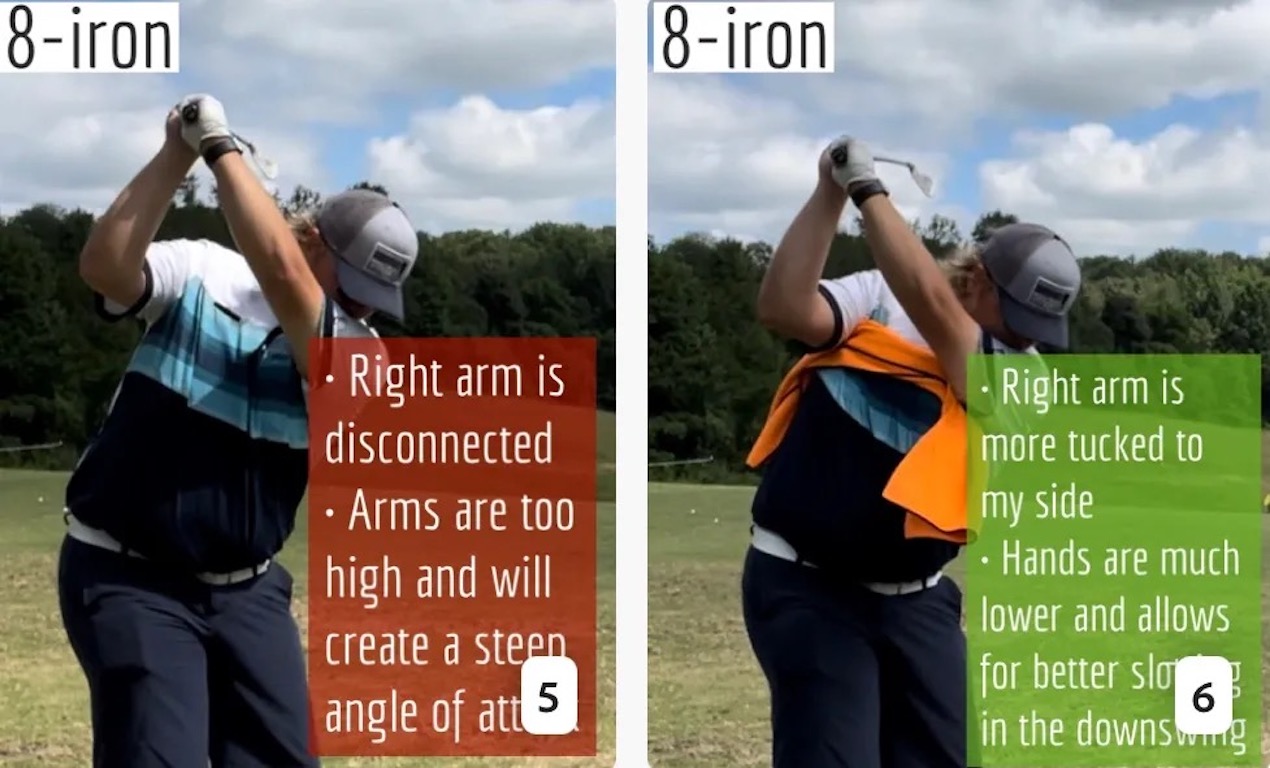
This is a classic drill that has been used for decades. However, the world of marketed training aids has grown so much during that time that this simple practice has been virtually forgotten. Because why teach people how to play golf using everyday items when you can create and sell a product that reinforces the same thing? Nevertheless, I am here to give you helpful advice without running to the nearest Edwin Watts or adding something to your Amazon cart.
For the “scoring clubs,” having a solid connection between the arms and body during the swing, especially through impact, is paramount to creating long-lasting consistency. And keeping that connection throughout the swing helps rotate the shoulders more to generate more power to help you hit it farther. So, how does this drill work, and what will your game benefit from it? Well, let’s get into it.
Setup
You can use this for basic chip shots up to complete swings. I use this with every club in my bag, up to a 9 or 8-iron. It’s natural to create incrementally more separation between the arms and body as you progress up the set. So doing this with a high iron or a wood is not recommended.
While you set up to hit a ball, simply tuck the towel underneath both armpits. The length of the towel will determine how tight it will be across your chest but don’t make it so loose that it gets in the way of your vision. After both sides are tucked, make some focused swings, keeping both arms firmly connected to the body during the backswing and follow through. (Note: It’s normal to lose connection on your lead arm during your finishing pose.) When you’re ready, put a ball in the way of those swings and get to work.
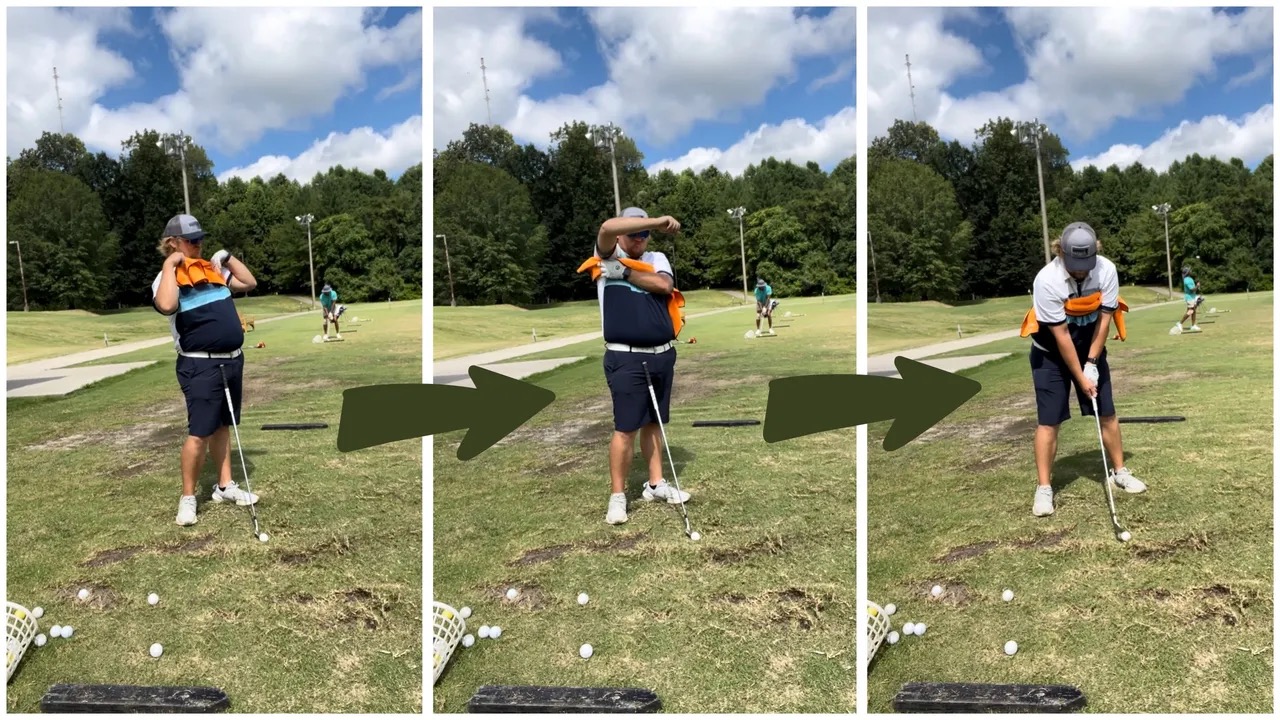
Get a Better Shoulder Turn
Many of us struggle to have proper shoulder rotation in our golf swing, especially during long layoffs. Making a swing that is all arms and no shoulders is a surefire way to have less control with wedges and less distance with full swings. Notice how I can get in a similar-looking position in both 60° wedge photos. However, one is weak and uncontrollable, while the other is strong and connected. One allows me to use my larger muscles to create my swing, and one doesn’t. The follow-through is another critical point where having a good connection, as well as solid shoulder rotation, is a must. This drill is great for those who tend to have a “chicken wing” form in their lead arm, which happens when it becomes separated from the body through impact.
In full swings, getting your shoulders to rotate in your golf swing is a great way to reinforce proper weight distribution. If your swing is all arms, it’s much harder to get your weight to naturally shift to the inside part of your trail foot in the backswing. Sure, you could make the mistake of “sliding” to get weight on your back foot, but that doesn’t fix the issue. You must turn into your trial leg to generate power. Additionally, look at the difference in separation between my hands and my head in the 8-iron examples. The green picture has more separation and has my hands lower. This will help me lessen my angle of attack and make it easier to hit the inside part of the golf ball, rather than the over-the-top move that the other picture produces.
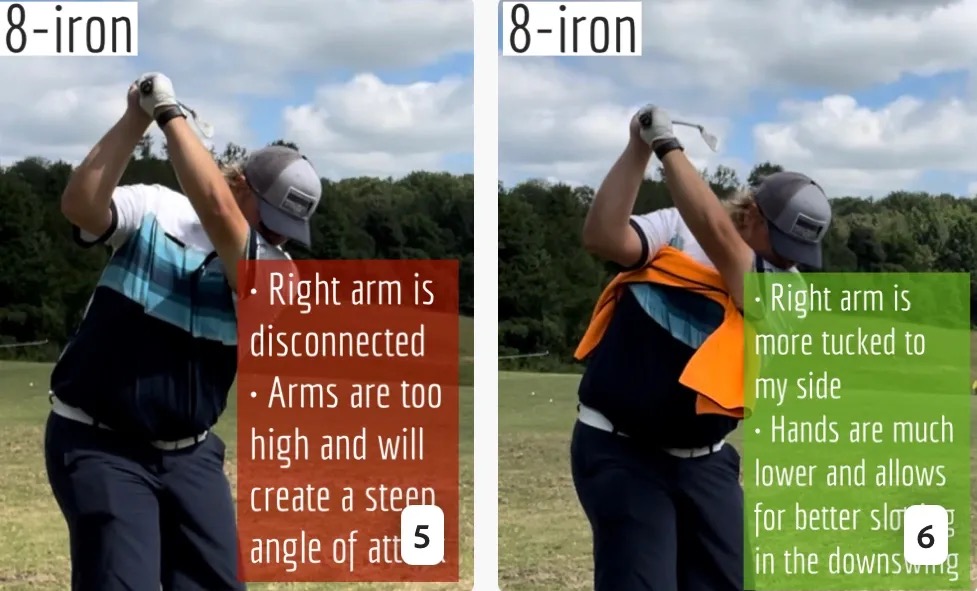
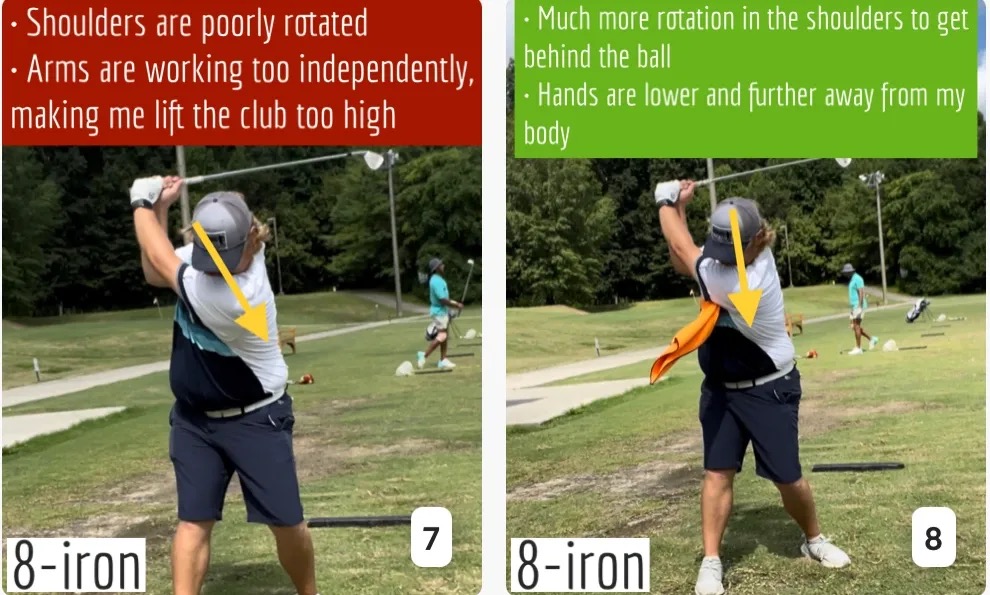
Stay Better Connected in the Backswing
When you don’t keep everything in your upper body working as one, getting to a good spot at the top of your swing is very hard to do. It would take impeccable timing along with great hand-eye coordination to hit quality shots with any sort of regularity if the arms are working separately from the body.
Notice in the red pictures of both my 60-degree wedge and 8-iron how high my hands are and the fact you can clearly see my shoulder through the gap in my arms. That has happened because the right arm, just above my elbow, has become totally disconnected from my body. That separation causes me to lift my hands as well as lose some of the extension in my left arm. This has been corrected in the green pictures by using this drill to reinforce that connection. It will also make you focus on keeping the lead arm close to your body as well. Because the moment either one loses that relationship, the towel falls.
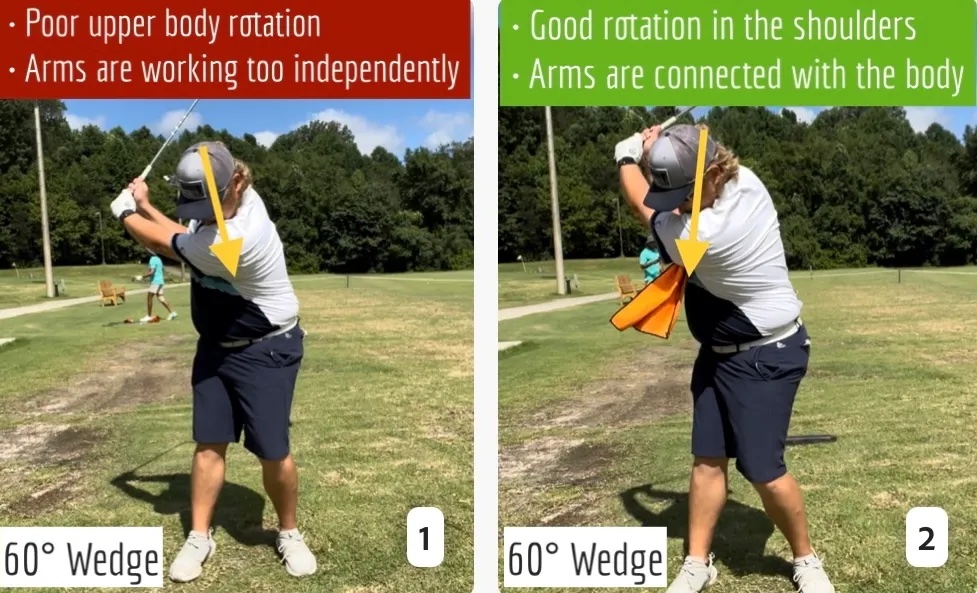
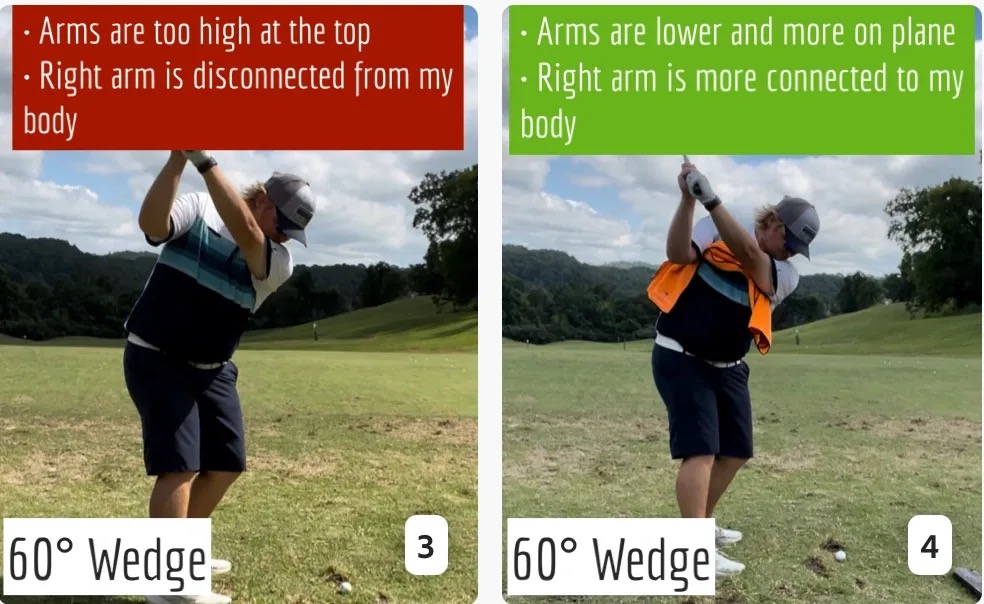
Conclusion
I have been diligent this year in finding a few drills that target some of the issues that plague my golf game; either by simply forgetting fundamental things or by coming to terms with the faults that have bitten me my whole career. I have found that having a few drills to fall back on to reinforce certain feelings helps me find my game a little easier, and the “towel drill” is most definitely one of them.
- LIKE12
- LEGIT2
- WOW2
- LOL0
- IDHT0
- FLOP2
- OB0
- SHANK8
-

 19th Hole2 weeks ago
19th Hole2 weeks agoDave Portnoy places monstrous outright bet for the 2024 Masters
-
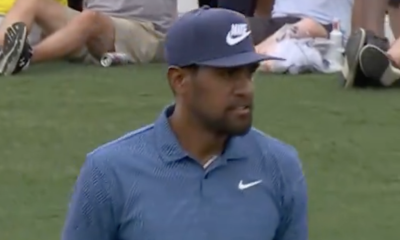
 19th Hole3 weeks ago
19th Hole3 weeks agoThings got heated at the Houston Open between Tony Finau and Alejandro Tosti. Here’s why
-

 19th Hole2 weeks ago
19th Hole2 weeks agoTiger Woods arrives at 2024 Masters equipped with a putter that may surprise you
-

 19th Hole2 weeks ago
19th Hole2 weeks agoReport: Tiger Woods has ‘eliminated sex’ in preparation for the 2024 Masters
-

 19th Hole7 days ago
19th Hole7 days agoTwo star names reportedly blanked Jon Rahm all week at the Masters
-

 19th Hole5 days ago
19th Hole5 days agoReport: LIV Golf identifies latest star name they hope to sign to breakaway tour
-

 19th Hole6 days ago
19th Hole6 days agoNeal Shipley presser ends in awkward fashion after reporter claims Tiger handed him note on 8th fairway
-
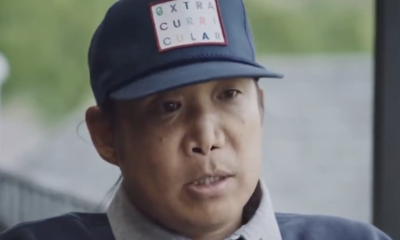
 19th Hole3 weeks ago
19th Hole3 weeks agoAddiction, spinal fusion, and scam artists – Everything Anthony Kim revealed in candid interview with David Feherty

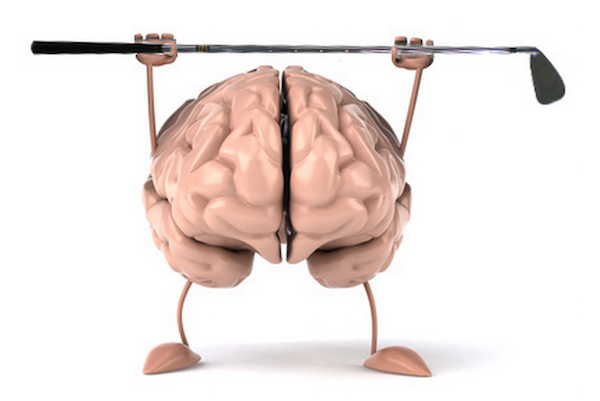







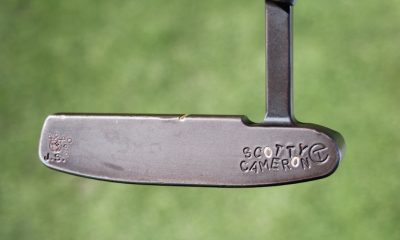

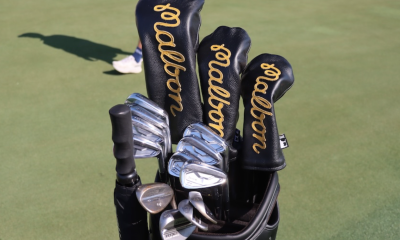



Rich Tarbert
Jul 13, 2015 at 12:24 pm
I am a multi-sport athlete. Grew up playing organized baseball and football, wrestled with friends for fun but never on a team, played pick up basketball wherever we could find a hoop, played softball, etc. I started playing golf, taking it seriously in my 40’s. I have never really had a great expectation to take my game anywhere other than having fun with my son or my friends. That being said, as a competitive athlete, the spirit of competition drives me to get better. Many instructors talk about different things, mental approach, swing speeds, technical thoughts, flow swings, tempo, and so on. In the end like every other sport it truly comes down to what I refer to as “Being Brilliant with the Basics”. I have a Marine friend of mine, who said this one day, and it took me by surprise not from him, but the profound meaning it conveys. If we stop, think, and get out of our own egotistical way for a few minutes a day, we can all become better golfers, ballers, fisherman, etc. Why is this? Because there are fundamentals in every aspect of life. It si when those fundamentals get of whack that we find ourselves in struggle. I learn this in golf by watching my son play High School Golf. I taught him the fundamentals as I learn from reading books, watching DVD’s, watching the pro instruction online, on TV, etc. I have taken him to several different PGA pro’s trying to find the right one that he relates to best, so he can work with them to take him to the next level. In those meetings, every one of the PGA Certified Pro’s has commented on the soundness of his fundamentals. All of them have only made very minor adjustments, and all said it wasn’t from what he was taught to do or could do, it was from him not executing his fundamentals on each and every shot consistently and as perfectly as he possible could. So I asked what can be some causes? They all have said, he has to learn to get out of his own way, put his ego down, and execute his fundamentals that you and he have worked out. They have compared his swing to the likes of Adam Scott, Jason Day, etc. Even the pro’s hit bad shots. So what is it that really makes us screw up on the first tee, shank a wedge when you have a prefect distance to dead center green with the pin just to the right and what should be an easy birdie? Execution of the fundamentals! To all on this post, there is no other way. You have to go to the range and do your technical work, get those fundamentals down for each club, then go play nine holes. If you execute your fundamentals on each and every shot and you know you carry distances, you will play better golf, lower your handicap, have more fun, and so on. That is a guarantee. How do I know? I started out as a 26 handicap, bought set of fitted clubs, had no clue what a good solid golf swing was, so I hit the range day in and day out sometimes two times a day. Along my way, people would stop by and say you are doing this and that. So I would try it. Never worked, I got mad and almost quit! But again, I am a athlete, now a retired US Marine of 27.5 years, and I will be damned if I am going to let something beat me! So, I talked to the pro’s. I did not have money for lessons, so I read, watched, tried, tweaked, etc. to teach myself. So in a mini tournament one of the club pro’s the one who fit my game improvement clubs, stood on the first tee with me, told me to swing at 60% off the first tee, mind my fundamentals, and pipe it down the middle. I asked why 60%? He said, take you shot, then I’ll tell you, but only if you pipe it down the middle. So, I take my shot, it was a beautiful baby draw! He looked at me and said “That is a great start to your good day!” So, I asked him why 60%? He said, he has watched all the better players tee off, most of them missed the first fairway, because they were thinking winning prize money and gifts, closest to the pins, etc.. I wanted you to think fairways and greens by executing your fundamentals, and at the end of the day, when you turn in your scorecard, I will be there to tell you the rest. So, off I went a 26 handicap, I hit more fairways that day, and a few more GIR’s, but most importantly I stayed out of trouble, I was in roughs and a few bunkers, but not like normal. I played an 87 that day. My score ever to that point. At the end of the day, back at the cookout, the Pro started calling out winners names, the last was the overall winner, my name had not been called, but I was a 26 handicap, so I had no expectations, then he called my name. I couldn’t believe it. I was shocked. I went up collected my prize check, and gift for being the worst best golfer that day! I did not understand the handicapping at that point, and when he explained it to me, he said “Now you know why I told you to execute your fundamentals on each and every shot. You will only get better from here, but only if you execute your fundamentals, don’t try to over power the course, the ball, the clubs, swing for the fences, etc., swing within yourself to your capability, take or two more clubs if you have to, but swing in rythmn and tempo, with a clear mind on each shot, remembering every shot has a purpose! For a while I did get better, then it fell apart, why? Because I wasn’t executing my fundamentals. Now that I am back and playing pick up games again, I am getting better, and shooting better scores! I only hit driver on 3 or 4 holes per round, because I play to my strengths and to what I can do, not what I want to do. It takes discipline to watch your buddies pull driver and be in the rough 50 – 60 yards ahead of you, but knowing that I am splitting fairways with irons, with better second or approach shots, makes this game worth playing again. My fairways hit percentage has increased immensely, my GIR’s has increased significantly as well, which means my putting is getting better, which leads to lower scores and more FUN!!! Unless it is a Par 4 of more than 480 yards, I don’t hit 3W, or Driver. I may use a hybrid of 5W periodically but only if I am feeling it! If not, I go to 3 – 4 iron. No matter what I always play the hole from center green back to tee. I want all of my approach shots to be within 150 yards, this is my comfort zone with 7, 8, 9, PW, 51 or 56 degree wedge. So along with my discipline to take the right club off the tee and before I strike that first shot, I have analyzed the hole, and while I don’t focus on where trouble is, I am aware of it, and I look at my yardages to center fairway and center green. I hit the ball fairly straight with a butter fade or baby draw. so on a 488 yard par 4, I subtract 150 leaving me with 338 yards. I don’t drive the ball with driver that far so I break that down, I take a look at the first sign of trouble, I stay clear of that trying to remain dead center fairway. Once that is accomplished usually around the 200 yard mark, I then break down the distance of the second shot, so in this case I am 200 off the tee, so lying 288 to the center of the green, I know I want to be within 150 of the green, I can’t fly it 288 and stick it, so play to a 100 yards or so, plus or minus roll, usually with a 6 -7 iron, if that works out for me, then I know I have a wedge in, and now I focus on 2-3 feet from the pin and mostly underneath the hole. I am seeing more Par’s when more birdie opportunities. Birdies are usually longer putts, and I am working on that and short game more and more now. BE BRILLIANT WITH YOUR BASICS!! Play better golf!!
Mark
May 28, 2015 at 7:46 pm
I’ve been playing this game for 50 years. Seen many different swings and played with golfers of all abilities. Some have been professionals or top amateurs others were weekend hackers.
This much I know. 95% of all poorly executed shots, regardless of ability, are caused by a basic error in grip, stance, posture or alignment, resulting in an inability to maintain core stability and the correct release of the club head through the back of the ball, perpendicular to the intended line of flight.
As a result, balls all too often land a long way from the desired position from which to play the next shot. Only ‘scratch’ golfers come close to executing the strategy you recommend. Playing smart for Mr Average involves trying to create often impossibly ambitious recovery shots to get the ball back in play.
Good article but a ‘go to’ shot would be redundant if we all concentrated on mastering the fundamentals.
John Haime
May 29, 2015 at 9:07 am
Thanks so much for the comments Mark – good insights.
Completely agree that golf is a game of fundamentals and having good fundamentals is the foundation of a good game. I also believe knowing your own strengths is key notwithstanding good fundamentals. Don’t forget the aspect of preparation mentioned in the article. This is also a key – but very poorly done by almost all golfers – especially higher handicaps.
Please note that those impossibly ambitious recovery shots often compound the problem and further elevate the numbers on the card. Playing smart is not hitting shots you have not practiced or shots beyond your capabilties.
Thanks again for a good contribution to the conversation!
Stay tuned for more in the coming months to address other challenges.
Peter
May 28, 2015 at 6:31 pm
A good piece of advice I was told by Nick Faldo is; “make an aggressive swing to a conservative target” this applies for every shot either from the tee / approach or wherever. Most golfers get into trouble doing exactly the opposite, they pick an aggressive target (for their ability) and as a result end up making a very conservative swing.
John Haime
May 28, 2015 at 9:57 pm
Great addition to the comments Peter – completely agree. It really is about commitment to an appropriate target. I think some players think that consideration of hazards and penalties is negative – but it is the smart way to play to consider the course’s strengths and limitations, your strengths and limitations … and then match them up.
Thanks for sharing,
Andrew
May 27, 2015 at 12:02 pm
Great insight John. For players just starting to play the game, a 10 handicap, or a tour pro, this article applies to them. In regards to #4, it’s hard to forget how many majors for which Tiger’s go-to shot played a crucial role. The “stinger” will live forever in my book and be somewhat of my go-to shot as well. Tiger has seemingly been as errant as anyone with the driver (with an exception being 1999-2000), even more evidence to mimic such tactics. Although Tiger was able to play the stinger with multiple clubs, it’s not something I would advise to the average golf who doesn’t practice/play 8 hours a day to mimic.
Bacon
May 26, 2015 at 3:58 pm
I’m a 11 handicap who fully understands what this article is about. However, after reading the first 3 paragraphs I couldn’t help but get past the following:
1. I’m supposed to play my miss, but do I swing expecting to hit the miss or expecting to hit a good shot? Most holes that I play I would have to aim into the trees on the right in order to keep my miss in the fairway, but if I hit it the way I plan to I’d then be in the right trees. The idea is good if you have a gaping fairway w/ very little trouble on either side.
2. I can throttle back on the club off the tee, knowing I will still have a manageable second shot distance. Inevitably, whenever I do this my “safe” tee shot is now a chunked 3W/hybrid/iron (regardless of what club it is). So I’m screwed anyway.
Adam
May 27, 2015 at 9:22 am
Bang on!
I can’t tell you how many times I made the smart decision only to shank the shot or put an uncharacteristic flight into a hazard.
Sometimes approaching a shot in Hero-mode actually makes me execute a better, more confident stroke instead of the usually “too-easy”and safe shot which is less natural and is accompanied by doubt and expectations of trouble.
Daniel
May 27, 2015 at 9:40 am
I’ve had this problem to in the past. I found that what I was doing was choosing the smart play and then making a tentative swing that tried to guide the ball into the fairway. As you can guess that formula produced some awful shots and lots of frustration. What I have done to lessen the problem is to pick the smart play just like before and then make sure to take a normal aggressive swing. The main thing is to not be tentative.
John Haime
May 27, 2015 at 2:01 pm
Hey Adam – thanks for the comment!
I think that it’s important to note, as mentioned in the article, that there is an initial macro focus to have a realistic view of the hole and where the trouble is. After all, considering trouble is not negative – it’s smart! Once you have done that you can narrow your focus (more positive). Taking an initial “wide” look limits big mistakes by widening your margin for error. As you know golf is a game of mistakes so awareness around this is important.
I think the “hero” mentality may work periodically – but will also put big numbers on your scorecard! Keep in mind there are times in a round where paying attention to the “yellow” light is key to making a score.
Happy that the article made you think about it – hope to help more in the coming months.
The best to you.
John Haime
May 26, 2015 at 3:07 pm
Great comment Scooter – thanks!
Yes, important to gauge and play within your own abilities. If most golfers could play smarter and eliminate penalty shots – especially early in the round – many shots would be saved.
Greg V
May 26, 2015 at 2:56 pm
Talk about playing smart? On par three’s, club yourself to the back of the green, especially if there is trouble in front and not in the back.
I used to work at a golf course re-seeding the tees on par 3’s in the afternoon when my main responsibilities were over. Most everyone came up short. I can’t remember anyone coming up over the green. And that goes for everyone that I play with, as well.
other paul
May 26, 2015 at 2:31 pm
I just played my best round ever by aiming for 100 yard markers off the tee. Almost holes out twice from the fairway. Started hitting my sand wedge really nice and getting them close. Worked great.
Mike Gomez
May 26, 2015 at 1:46 pm
@Mike. The problem is the people on the first didn’t even bother to aim left and play the slice. Therefore they likely double or trippled the hole when they could have easily walked away with par if they simply thought about hole before going yak yak yak to their buddies and swinging away.
Mike
May 26, 2015 at 11:51 am
Would’t the “stock shot” idea only be applicable to better players? I’m a 5 handicap and don’t have a “stock shot” and I know most if all higher handicaps certainly do not hit the ball with any consistency to be able to hit that “stock shot”.
In addition to this, what do you do if you are a short hitter on that 410yd par 4 or don’t hit your 3 wood any straighter than you do your driver? Do you knock it all the way down to a 180yd 5i off the tee with 230yds left and play it as a par 5?
Not a criticism of the article, but questions to better understand your logic.
Adam
May 26, 2015 at 12:32 pm
I’m a 13 handicap and last season I started the year by practicing a stock shot. I stopped swinging aggressively while trying to aim straight. I spent a few sessions on the range just working on hitting a fade at about 75%. for me this meant I would align myself to my target and hit a shot that intentionally started in the direction of the left rough and then curved back to the middle. This meant if I did miss, then I’d either pull it but likely still be in play, but more often my miss would fade too much but I’d be safely on the right side of the fairway at about 240 yards. If everything went perfectly I would be in the center of the fairway at about 250 yards.
This is significantly shorter than my potential distance, but it led me to 65% fairways and 90% playable second shots.
Granted I did spend this past off-season straying from this “safety”shot because I wanted the extra 40 yards that I get with a baby draw, but it should be noted even though I now average 285 yards from the tee, my fairways hit have decreased to 50% and my playable 2nd shot is around 85%.
So the stock shot is possible, and very likely the better approach. If only I could fully suppress the ego!
Adam
May 26, 2015 at 12:43 pm
I would also note that the majority of bad decisions I make in a round aren’t from the tee, but more times it’s going into hero mode from the rough or on approaches on par 5s. I probably give away up to 5 strokes a round by not talking myself down from unnecessary risks.
Scooter McGavin
May 26, 2015 at 1:51 pm
I think what you just said about using an iron could still be viable for a number of players. If they can at least keep their irons straight and get to the green in 3, they will be hitting their 3rd from 50 yards out and at least still have a chance for par, and an even easier chance at bogey. Compare that scenario to slicing into the water and having to drop and hit your 3rd shot from 150-200 yards away. Most high handicappers are then going to make 6 or worse. You have to take into consideration whom this approach is geared toward. Sure, a really good golfer may be aiming for birdies and so this wouldn’t be the best method, but a 15 hcp would usually be pretty happy with a par or bogey on the first hole. And also remember that it is only being suggested for the first few holes, so the player gets comfortable. Just my $.02.
Mike
May 26, 2015 at 3:15 pm
I’m going to play my home course tomorrow and every hole I’m even remotely scared of being in my pocket for my second shot I’m going to hit a 5i or 6i off the tee and see how it turns out. My guess is that the 180-200yd tee shots will probably put my second shot in jeopardy or I’ll have to make a decision to play to a par 4 in 3 shots, BUT I want to see how it will turn out.
John Haime
May 26, 2015 at 3:14 pm
Hi Mike,
Certainly well within the capabilities of a 5 handicap to develop a stock shot. It might be with a hybrid or a club you are comfortable with.
Alot of the article is about understanding what you do well, what your limitations are and making sure you are playing that chess match with the course – and winning the match! Playing within your capabilities and not wasting shots! If you are a very good wedge player – a 5 iron on the hole might be the play. If you aren’t, consider what might be a play for you where you can use your strengths.
If you feel uncomfortable on a hole – do what it takes to keep the ball in play and always play to strengths.
Great comment – thanks!
Alex
May 26, 2015 at 4:15 pm
My handicap’s 4 and I do have a go to swing or shot so I guess you’ve got the skill to develop one. My go-to shot’s a 3/4 swing that hits a lowish baby draw. I usually take 1 or 2 more clubs and go for it when I’m out of sync or try to get out of a mess. The go-to is a real life-saver during the round. Go get yours.
John Haime
May 27, 2015 at 8:41 am
Great example Alex – everyone must find their own stock shot that they can trust when needed. Sounds like you’ve found yours.
Thanks for the comment!